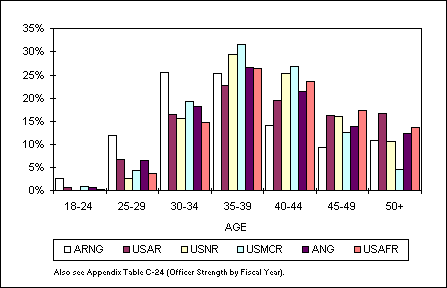
| |
|
|
|
|
|
|
|
|
|
|
|
|
|
|
|
|
|
|
|
|
|
|
|
|
|
|
|
 |
|
|
|
|
|
|
|
|
|
||||||||||||||||||
| |
|
|
|
|
|
|
|||||||||||||||||||||
| |
|
|
|
|
|
|
|
||||||||||||||||||||
| |
|
|
|
|
|
|
|
|
|
||||||||||||||||||
| |
|
|
|||||||||||||||||||||||||
|
Characteristics of Selected Reserve Officer Accessions and Officer Corps Age The differing missions and force structures of the Reserve Component affect the age composition of the officer corps as shown in Figure 6.2. The USAR, USAFR and USNR have the largest proportions of officers aged 40 and older (53, 55, and 52 percent, respectively). Conversely, the ARNG, USMCR and ANG have smaller proportions of officers 40 or older (34, 44, and 48 percent, respectively). The ARNG, ANG and USAR have the greatest proportions of officers aged 29 and younger (15, 7 and 7, percent, respectively), while the USNR has the smallest proportion of officers aged 29 and younger (3 percent). Recruiting policies affect the age structure of the Selected Reserve officer corps. As in the Active Component, one might expect the USMCR to have a greater proportion of younger officers than the other Reserve Components. However, this is not the case. The USMCRs policy to recruit only officers with prior military service increases the age of its officers. 
Figure
6.2. Percent of Selected Reserve officer corps by age group, FY 2000.
|